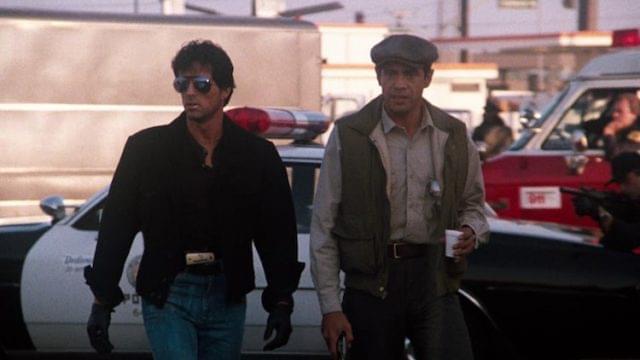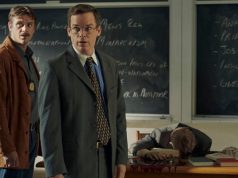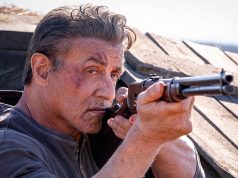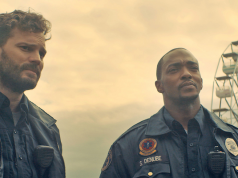
“Cobra” is a cool title for a movie, sure, but the coolness is diminished by the fact that it has nothing to do with the movie it’s the title of. The main character is named Cobretti, and “Cobra” is his nickname. So what? If he were an actual cobra, that would be neat. Even being a human with the powers of a cobra would be OK. But just being nicknamed “Cobra” because it happens to sound like his last name? A last name that the movie invented for him in the first place? NO SALE.
Sylvester Stallone is Cobra. He wrote the screenplay, too — which, if he writes anything like he talks, means he banged his fists on a typewriter for a couple hours, then ran it through a Meathead-to-English translator. Cobra is a Los Angeles cop who doesn’t play by the rules and who only gets called in after all the regular police methods have failed. That’s what we’re told, anyway. In truth, Cobra’s methods are quite reasonable, and he’s only needed because the regular cops are incompetent.
Take the opening sequence, for example. A madman has entered a grocery store, opened fire on the shoppers, and taken the survivors hostage. (Earlier, the movie showed him parking his motorcycle in a handicapped spot. Apparently someone was afraid that shooting up a supermarket wouldn’t be enough to establish that the character is a scofflaw.) The hostage situation has reached a standstill, so the cops reluctantly call in Cobra, who drives up in a 1950 Mercury, chewing on a matchstick — movie shorthand for “Look! This character is quirky!” (Or: “This character has pica!”)
Cobra’s strategy to end the standoff is to walk in the front door of the supermarket, which the terrorist didn’t bother to lock or even keep an eye on. He’s in the back of the store, near the meat counter, with his hostages. This allows Cobra to sneak around unobserved and get a clear sniper shot at the bad guy. (Note that so far, Cobra is doing what any police officer of average skill could have done.) Cobra doesn’t take the shot, though. Instead, he confronts the villain openly and engages him in tough-guy banter — hey, when you’re as eloquent a speaker as Stallone, you take every opportunity to show it — before finally shooting him, saving the hostages and ending the crisis.
Outside, a TV news reporter angrily questions Cobra’s use of deadly force, never mind that shooting a madman who has already killed several people and is holding a gun to a hostage’s head is a perfectly legal, legitimate, and uncontroversial police procedure. Cobra responds by shoving the reporter and expressing disgust at what a weak-willed, criminal-coddling pansy he is. This straw-man argument is meant to fire up the easily fired-up portion of the audience. You think, “Yeah! That reporter is an idiot for thinking police shouldn’t disarm dangerous criminals!” before realizing that wait a minute, no one actually thinks that.
But this is all irrelevant. The film’s real plot has to do with a serial killer called the Night Slasher who’s been wreaking havoc on L.A., murdering people “at random,” though all the victims we see are young, attractive women. The cops have no leads, possibly because they think obvious patterns are “random.” As a last resort, they assign Cobra to the case. Monte (Andrew Robinson), a really nerdy and wimpy detective who wears GLASSES, is opposed to this because Cobra is reckless, doesn’t follow the rules, yada yada. And sure enough, the first thing Cobra does after being assigned to the Night Slasher case is to go around town talking to lowlifes and known criminals, trying to get some leads. THAT MAVERICK! THAT LOOSE CANNON! Once again, the movie portrays Cobra as a renegade anti-hero simply for performing the basic duties of a police officer.
Meanwhile, we learn a few things about this Night Slasher person. For one thing, Cobra’s suspicion that it’s actually a group, not a single person, is correct. (The fact that Cobra has no evidence for this theory doesn’t matter. In movies, “excellent police work” and “guessing correctly” are synonymous.) The group is a cult of some kind whose members gather in a warehouse, hold up axes and sledgehammers, and swing them around in a well-choreographed fashion. The supermarket guy, who was apparently one of them, made mention of a “New World,” but to look at them they could just be the cast of “Stomp” in rehearsal. Note that I do not reject the possibility that they’re the cast of “Stomp” AND a doomsday cult.
The cult’s leader is a beefy-jawed fellow played by Brian Thompson. Since the character doesn’t have a name, we’ll just call him Brian. Brian the cult leader. Brian and his fellow murderers are out doing their murder thing one night when a witness happens to drive past. Her name is Ingrid Knudson, she’s played by Brigitte Nielsen, and she works as a fashion model (within certain limited definitions of the word “fashion”). Brian is a very private person who doesn’t like it when people witness his murders, so he orders a hit on Ingrid one day as she leaves a photo shoot. Several bystanders are killed, but Ingrid herself is unharmed, though for some reason she still has to stay overnight in the hospital, possibly so doctors can determine whether her Danishness was a pre-existing condition.
Ingrid is in danger, obviously, so a police officer is assigned to guard her hospital room. The cop stands at the nurses’ station instead, flirting, and when Brian shows up in a janitor’s disguise, the cop stays behind while a nurse goes to check on why there’s a janitor here so late at night. Brian kills the nurse, Ingrid narrowly escapes and runs screaming into the hall, and the cop is nowhere. He has literally disappeared from the film altogether. No one else is around, either — this entire floor of the hospital has been deserted. To attract attention while Brian pursues her, Ingrid pulls a fire alarm — and now, suddenly, there are HUNDREDS of patients, nurses, and other hospital employees streaming out of the rooms.
Somehow, Cobra is blamed for all this. Seriously. There’s a scene back at headquarters where Monte (WHAT A NERDY NAME!!) sees the fiasco as proof that he was right about Cobra, and all the other bosses are blustery and angry as well. None of this makes sense. My best guess is that when he was writing the screenplay, Stallone remembered that he had seen other movies in which lone-wolf cops are chewed out by their superiors for being unpredictable rule-breakers, and he figured his movie should have a scene like that, too. The fact that there’s usually a reason for the cops to be in trouble is a detail that escaped Sly’s notice, as did the fact that Cobra hasn’t actually broken any rules yet.
Cobra’s plan now is to take Ingrid out of Los Angeles altogether, essentially ceding the city to the bad guys. Staying at a roadside motel, Cobra finally lives up to his reputation as a rule-breaker by having sex with Ingrid, thus violating the laws of nature, God, and man. Just imagine those smooth, giant bosoms laid bare, rubbing up against Brigitte Nielsen.
As you might expect, the entire cult finds them and lays siege to the motel, whereupon Cobra and Ingrid escape into an orange orchard, and from there into a nearby factory, in accordance with Hollywood law requiring that all action movies have their climactic scenes in factories. As you might also expect, it comes down to a face-off between Cobra and Brian, resulting in Cobra impaling Brian on a hook and then setting him on fire. I will grant you that this might be a slight deviation from standard police procedure. Still, it’s not any different from the way cops (and civilians who reluctantly become action heroes) usually end things in movies like this, so I don’t know why Cobra’s getting all this heat from his bosses. Especially that stupid MONTE! What a dork that guy is!!
— Film.com





